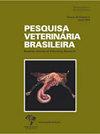细胞增殖和凋亡标志物作为猫皮肤鳞状细胞癌电疗预测因素的评价
IF 0.8
4区 农林科学
Q3 VETERINARY SCIENCES
引用次数: 0
摘要
摘要:通过免疫组织化学检测细胞增殖率和肿瘤凋亡,可以评估肿瘤的生物学行为,优化患者的临床过程。本研究旨在分析Ki-67、COX-2和caspase-3在猫皮肤鳞状细胞癌(SCC)中的免疫组织化学表达,并将其与ECT反应类型进行关联,从而确定这些变量的预测潜力。为此,我们在ECT前对13例猫皮肤SCC样本进行评估,并使用Spearman相关系数对变量之间的相关强度进行统计分析,显著性水平为95%。结果显示,组织病理学分级与ECT反应呈显著负相关(ρ=-0.6;p = 0.03);Ki-67、COX-2和caspase-3免疫表达与ECT疗效无显著相关性(ρ=-0.18;p = 0.54 /ρ= -0.23;p = 0.44 /ρ= -0.12;分别为p = 0.69)。因此,本研究表明,组织病理学分级、肿瘤大小和分期、细胞多形性程度和炎症浸润程度可被视为皮肤SCC的阴性预后因素和ECT反应的阴性预测因素。然而,标记物Ki-67、COX-2和caspase-3不被认为是ECT反应类型的预测因素。此外,这些免疫表达与更大的肿瘤侵袭性之间没有关系。本研究评估的SCCs显示显著的COX-2标记,提示潜在的治疗靶点。ECT已被证明是安全有效的局部控制猫皮肤鳞状细胞癌,但在较大和侵袭性病变的有效性降低。本文章由计算机程序翻译,如有差异,请以英文原文为准。
Evaluation of cell proliferation and apoptosis markers as predictive factors for electrochemotherapy in cutaneous squamous cell carcinoma of cats
ABSTRACT: Determining cell proliferation rates and tumor apoptosis through immunohistochemistry allows the evaluation of the biological behavior of the tumor, optimizing the patient’s clinical course. This study aimed to analyze the immunohistochemical expression of Ki-67, COX-2 and caspase-3 and correlate them with the type of response to ECT in feline cutaneous squamous cell carcinoma (SCC), thus determining the predictive potential of these variables. For this, 13 samples of feline cutaneous SCC were evaluated before ECT, and statistical analyses of the correlation intensity between the variables were performed using the Spearman correlation coefficient, with a significance level of 95%. The results indicate a significant negative correlation between histopathological grade and response to ECT (ρ=-0.6; p=0.03); there was no significant correlation between Ki-67, COX-2 and caspase-3 immunoexpression with the response to ECT (ρ=-0.18; p=0.54/ρ=-0.23; p=0.44/ρ=-0.12; p=0.69, respectively). Therefore, the study shows that the histopathological grade, tumor size and staging, degree of cellular pleomorphism and degree of inflammatory infiltrate can be considered negative prognostic factors for cutaneous SCC and negative predictors for response to ECT. However, the markers Ki-67, COX-2 and caspase-3 are not considered predictive factors for the type of response to ECT. In addition, no relationship between these immunoexpressions and greater tumor aggressiveness was observed. The SCCs evaluated in this study showed significant COX-2 labeling, indicating a potential therapeutic target. ECT has been shown to be safe and effective for local control of feline cutaneous SCC but with reduced effectiveness in larger and invasive lesions.
求助全文
通过发布文献求助,成功后即可免费获取论文全文。
去求助
来源期刊

Pesquisa Veterinaria Brasileira
农林科学-兽医学
CiteScore
1.30
自引率
16.70%
发文量
41
审稿时长
9-18 weeks
期刊介绍:
Pesquisa Veterinária Brasileira - Brazilian Journal of Veterinary Research (http://www.pvb.com.br), edited by the Brazilian College of Animal Pathology in partnership with the Brazilian Agricultural Research Organization (Embrapa) and in collaboration with other veterinary scientific associations, publishes original papers on animal diseases and related subjects. Critical review articles should be written in support of original investigation. The editors assume that papers submitted are not being considered for publication in other journals and do not contain material which has already been published. Submitted papers are peer reviewed.
The abbreviated title of Pesquisa Veterinária Brasileira is Pesqui. Vet. Bras.
 求助内容:
求助内容: 应助结果提醒方式:
应助结果提醒方式:


